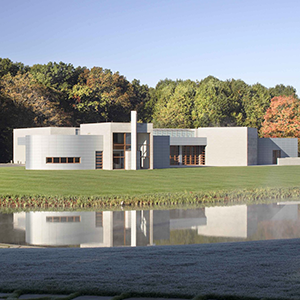There’s that time in each of our lives where we need a break from the
mundane, a haven from the exhaustion that is the standard work desk. The
legs need a chance to move around, and the heart a chance to absorb some
fresh oxygen. Why not try that in an artistic way?
That’s what makes the Glenstone Museum, located in Potomac and created by
Mitchell and Emily Rales, such a surreal experience. There are few
locations in the world similar to it, where art and landscape come together
in harmony to form a contemplative environment for young teenagers and
adults.
Immediately after driving through the gates, there stands a figure that
seems a hundred feet tall. It could be a monkey, it could be a new
creature, but artist Jeff Koons deserves kudos for decorating the sculpture
with thousands of living flowers. It’s a grand and welcoming taste of
what’s to appear in the private exhibit.
Now, a walk in the woods can hearken back to childhood memories, playing
with sticks and walking down paths that feel as if they are endless to the
younger mind. As you reach the end of the trail, you find yourself in a
setting to listen to the multimedia presentation, “Forest (For a Thousand
Years).” Married couple Janet Cardiff and George Bures Miller compiled a
myriad of noises to create each individual’s perception of nature. Everyone
sits on tree stumps while they listen to the Estonian choir, to the echo
that comes from the deep basses. Or perhaps they’re covering their ears to
the sounds of the World War II-era tanks and bombs (this piece was made
for, and debuted, in Germany).
If you can sneak your way into a tour led by the docents, there’s the
chance to explore in depth the work of Andy Goldsworthy. His mission was to
create houses made from land native to the Potomac area. One project of his
is a ball of clay that is multiple people standing with arms opened wide.
The ball sits in what feels like an air-conditioned building. The twist is
that the art itself keeps the small viewing space cool. Someone on my tour
asked how a large ball of clay could sit in a room without having to be
heated at a thousand degrees Fahrenheit like ordinary clay sculptures. The
guide told us to look into the cracks – hair! Yes, human hair, rat hair and
all sorts of other animals’ hairs are what binds the clay together.
This feature won’t last forever. The guide said that Goldsworthy wanted the
collection to be ephemeral, to last for a short amount of time. As the land
erodes, so will his clay sculptures, and thus is the way with nature. One
thing that will never change according to the Rales’ vision, is the
landscape. The marvel of the whiff of the green plants and the wind from
the trees is to remain permanent. The nature is its own art, something to
admire thanks to its vastness.
The last great spectacle is the indoor gallery. This section features one
individual artist and his or her work. The current highlight is Louise
Bourgeois, a French-American artist revered for her work with sculptures
and installations; she is also a printmaker and painter. The gallery tours
through her body of work and illustrates how her style and creations have
changed over time. Her dark but sexy craft comes out in a lot of her
sculptures, which were a revolution for feminist vulnerability. Some of my
favorites are “Destruction of the Father,” “The Tomb of a Young Person” and
“Le Défi IV.”
What makes Glenstone special is the staff itself. They aren’t there to lead
through the gallery and explain their perceptions; instead, they ask
visitors to provide their own interpretations, inviting different
perspectives beyond those of the artist and the curators. Whether you’re 12
or 112, they will encourage discussion of what is seen at Glenstone, and
how it may change your view of day-to-day life.
“To each their own;” that’s how I’d describe Glenstone. No two people will
walk out with the same thoughts. Whether you want to go at your own pace or
sit and enjoy the ambience of the outdoors while contemplating the works’
surroundings, there is no wrong way to experience it.


